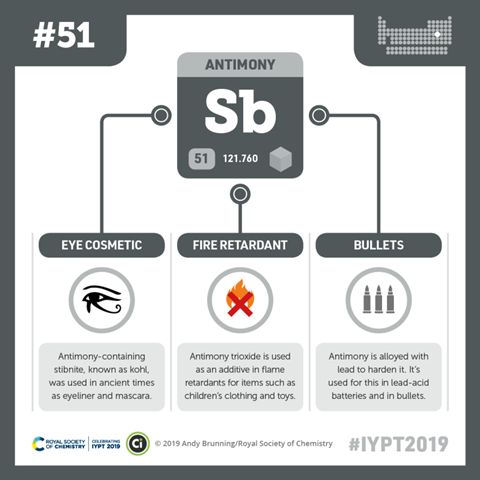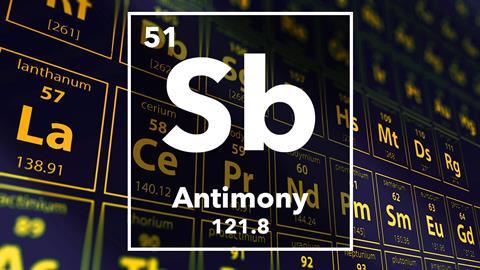Chris Smith
Hello, this week we meet the chemical that's maimed and murdered, but often with the best intentions. To tell the story of the element that can't quite make up its mind if it's a metal or not here's Phil Ball.
Phil Ball
Many wars have been fought over territory, some over pride or love or money. But in the 1600s a long and bitter war was waged over antimony.
What, you might ask, is there to fight about in this apparently unremarkable element, a soft, greyish metal that doesn't even conduct electricity well enough to qualify as a true metal? It has its uses, but they are mundane: as an alloy component of battery electrodes and of pewter, and as a flame retardant.
But at the heart of the Antimony War, which raged in France and Germany throughout much of the seventeenth century, was a more unlikely use of antimony. Some doctors of that age believed that it was a vital ingredient in medicine. The advocates and opponents of this point of view didn't actually take up arms: they fought with pen in hand, sometimes denouncing one another in terms far more vitriolic than we'll find in the academic literature today.

It's very curious that the subject of this dispute should be antimony, because this element is actually rather toxic, causing liver damage in large enough doses. But pharmaceutical uses of antimony have a long history. In the ancient world it was known primarily in the form of its black sulphide ore, called stibnite, which the Greek physician Dioscorides recommended for skin complaints in the first century AD. The Egyptians, meanwhile, used stibnite as a cosmetic, applying it as a form of mascara. They called it kuhl, meaning 'eye-paint', and to the later Islamic alchemical physicians this became al-kohl. From its original meaning of powdered stibnite, this term came to designate any powder, and then a potent extract of any substance. In the early sixteenth century the Swiss alchemical physician Paracelsus called a distilled extract of wine alcool vini, from where we get the modern word alcohol: a long and strange road from eye make-up to intoxicating liquor.
Paracelsus was particularly fond of antimony compounds as medicines. After his death, Paracelsus's chemical medicine was championed by many doctors in Europe, especially in France, and some of these made antimony their most prized remedy. One, a German salt-maker who wrote under the false persona of a fifteenth-century monk called Basil Valentine, published an entire book advertising antimony remedies in 1604 called The Triumphal Chariot of Antimony. Valentine admitted that antimony was poisonous - in fact he offered an apocryphal explanation for the name, saying that it derives from anti-monachos, meaning 'anti-monk' in Latin, because he once unintentionally poisoned several of his fellow monks by adding it secretly to their food in an attempt to improve their health. But he claimed that alchemy could be used to free the metal of its toxic effects and make it "a most salutary Medicine".

The Paracelsian chemical physicians were opposed by traditionalists who preferred the medical theories of the ancient doctors like Hippocrates, based on the idea that our health is controlled by a balance of four humours. This was partly a battle for academic power, but the rival camps were also split along religious and political lines. So there was a lot riding on the struggle, and for a time it crystallized around the medical value of antimony.
The toxicity of antimony can cause vomiting – but to its supporters, this was seen as a good thing. They would administer the salt antimony tartrate as a so-called emetic, a vomit-inducer that was believed to purge the body of other bad substances.
Some doctors continued to prescribe antimony freely after the inconclusive Antimony War, and it has been suggested that a fondness for antimony remedies was what actually killed Mozart in 1791. By the nineteenth century it had become a favourite slow poison for murderers eager to conceal their crimes – a chemical villain almost as notorious as lead.
Chris Smith
But would Mozart have been the maestro that he was without the help of Antimony? Well I guess we will never know. Thank you very much to science writer and author Phil Ball. Next week we'll be telling the tale of the element that at one time quite literally kept the world going, but not quite in the way you might think.
John Emsley
The summer of 1618 saw England gripped by drought, but as Henry Wicker walked across Epsom Common he came across a pool of water from which thirsty cattle refused to drink. He found that the water tasted bitter and on evaporation it yielded a salt which had remarkable effects: it acted as a laxative. This became the famous Epsom's salt (magnesium sulfate, MgSO4) and became a treatment for constipation for the next 350 years.
Chris Smith
350 years, certainly sounds like a bad case of constipation. Thankfully John Emsley will be running smoothly through the element with atomic number 12 and that's Magnesium in next week's Chemistry in its Element, I hope you can join us. I'm Chris Smith, thank you for listening, see you next time.













No comments yet